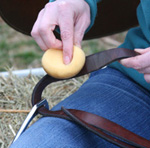 |
| Pay special attention to parts of tack that are subjected to a lot of wear, such as stirrup leathers. |
Riders put their tack through a lot of abuse. The dirt, sweat and horse slobber that saddles and bridles are subjected to in their daily use can break down the leather and stitching over time. While few riders have the time to give their tack a thorough cleaning after every ride, it’s important to make sure you don’t let the dirt get out of hand.
Daily Care
If you take a few steps to get rid of some of the superficial dirt after each ride, it will save you time and effort when you do attempt a major cleaning.
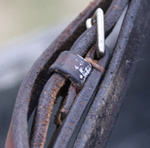 |
| Make sure you keep your tack dry. Mold thrives on damp leather. |
After you take off your horse’s bridle, wipe off the bit with a clean rag or towel. Some riders dunk the mouthpiece of the bit into the horse’s water bucket to rinse it off, but this is not as effective, and can subject the leather part of the bridle to regular soaking if you’re not careful. Cleaning the bit after each use will prevent the caked-on, dried slobber that can be a challenge to scrape off. A clean bit is also more pleasant for your horse to wear.
Many riders like their horses to work the bit in their mouths. The resulting foam around the mouth is often considered a sign that the horse has accepted the bit. However, when that saliva reaches the leather bridle, it can be damaging. Water weakens leather if it has a chance to soak in. Dried saliva can attract dirt, which will wear away at the leather, or it may cause mold over time. If your horse is a drooler, make sure that you wipe down the reins and cheekpieces near the bit on your bridle after each ride.
Similarly, if you’ve given your horse a solid workout or the weather is warm and your horse has worked up a sweat, be sure to at least wipe down any part of your tack that contacts the horse’s body. Generally a saddle pad will protect the underside of your saddle, but take the time to check. Sweat and the dirt it brings with it can cause irreparable damage to your tack.
Horses tend to sweat in the girth area even if they don’t break a sweat anywhere else, so it’s a good idea to make wiping off your girth after each ride a regular habit.
Thorough Cleaning
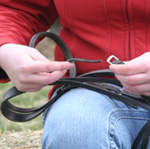 |
| Unbuckle every buckle to give your tack a thorough cleaning. |
If you compete with your horse, you already know that it’s important to give your tack a thorough cleaning before you enter the show ring. Though the condition of your tack alone probably won’t change the outcome of the class, judges do notice which exhibitors take the time to put that extra polish on their appearance.
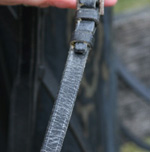 |
| Regular conditioning can help prevent leather from cracking, but too much can weaken your tack. |
However, if you don’t compete, it’s still important to take the time to clean and condition your tack. Dirt, sweat, dust and damp weather can damage your tack if left unchecked, and the last thing you want is tack that fails when you’re on a trail ride miles away from home.
Cleaning
When you can commit the time to a thorough cleaning, you’ll need to unbuckle each and every buckle. If you’ve used your bridle on the same horse for a long time, there will probably be a crease in the leather at the hole where the buckle goes. However, if the tack is relatively new or if you adjust it frequently, you may want to count the holes to where the buckle was set and write it down so that you know you’re putting the bridle back to the correct adjustment.
Start by wiping off any excess dirt from the surface of the leather. Then use a damp—not wet—sponge or cloth to work your soap into the leather. Small tack sponges, available inexpensively at any tack shop, are
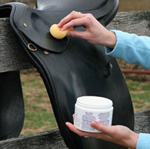 |
| Apply conditioner after cleaning while the leather is still slightly damp. |
ideal because they are soft and non-abrasive, and small enough to get into all areas of the tack. Make sure you concentrate on the areas around the buckles and the folds in the leather by the reins and in your stirrup leathers. Wipe off any excess soap residue with a damp cloth.
Conditioning
Before your tack is fully dry, work in a conditioner or leather oil to keep the leather supple and prevent it from drying and cracking. Many riders overuse oil with the intention of preventing the tack from drying out. There is such thing as too much oil, and over-conditioning your tack can make it flimsy. Avoid getting oil around the stitching on your saddle as it can rot away the thread over time, leaving you with unsafe tack and costly repairs.
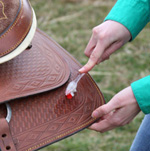 |
| Use a toothbrush to make sure no soap residue remains in the tooling. |
If you have a western saddle with decorative tooling in the leather, you’ll need to take some extra time to clean it properly. Using a soapy sponge can leave residue in the tooling. Some riders choose instead to use a toothbrush to provide a thorough cleaning.
Besides just getting your gear clean, a thorough cleaning is a great time to check your tack for problems. Most wear and tear on your tack occurs at the buckles or where the leather folds back in a loop, like where your bit connects to your bridle, so be sure to check for cracks and tears. Conditioning can help prevent leather from cracking, but it can’t repair tack that is already damaged. If you find serious tears in your tack, it may be time to repair or replace it.
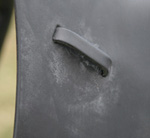 |
| Tack kept in damp conditions will often grow mildew and mold. |
Mold and Mildew
In a perfect world all tack rooms would be climate-controlled with dehumidifiers running full-time to protect leather from mold-friendly moisture. In the real world, damp weather in less-than-ideal storage situations means mold and mildew are a reality for many riders. Moldy leather has a white or greenish powdery substance on it. If left for a long time or in especially damp conditions, the mold can take root and cause serious damage.
If your tack is a victim of mold, dilute rubbing alcohol with water in a 1:1 ratio. Dampen a cloth with the mixture and wipe down the affected areas. Condition the leather afterwards and make sure you let your tack dry completely before putting it away, especially if you expect to store it for a while. Be sure to clean your moldy tack in a well-ventilated area so that you don’t have to inhale a heavy concentration of mold spores.
Read on to learn about caring for synthetic tack.
Read more about the active ingredients in your leather care products.






This was a very helpful article! Thanks!
good to know
Being a new horse owner I’ve noticed there is a lot to learn off the horse as well as on him; this article gave me great tips about the bit and not running it under water, (as I was shown) but instead wiping it with a damp rag. I especially appreciated the tip for cleaning mildew; I’m looking into buying an extra saddle and noticed there was mildew under the seat, now I can clean it myself! thanks again!
Good tips
Great tip on the diluted alcohol
Nice refresher
I am a big fan of the classic oil, and horsemans mine step conditioner, along with mad cow this has softened my my bridal and saddle. I also like to just use plane water to get the grunge and dirt of and every other day I shampoo and the end of the week I condition. This has helped alot